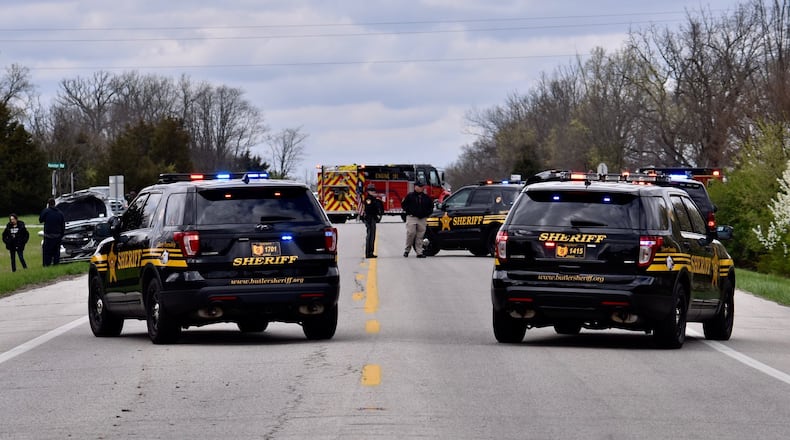Butler County Sheriff’s Chief Deputy Anthony Dwyer said the number of calls for help with disputes, including domestic violence, increased from 76 in February to 106 in March, and earlier this week the total for April was 79.
“Would I say that we’re getting some calls and reports because people have been on quarantine and are getting tired of it? I’d say yes,” Dwyer said. “Would I say that it is hugely significant? Probably not.”
RELATED: Protecting children: Butler County coping with changes to monitoring cases, foster care options
The calls have increased almost 40 percent but the character of the calls are “not to the point of sounding the alarm where it’s really, really, really gotten out of hand,” Dwyer said.
The Journal-News polled all the major jurisdictions countywide, and they reported a mix of domestic violence/disturbance calls received, reports taken and arrests made. Disturbance calls aren’t necessarily just between family members.
The largest leap in calls has occurred in Liberty Twp., where calls between February and March increased almost 95 percent from 19 to 37. Increased domestic violence calls have also occurred in Oxford (46 percent), Middletown (20.7 percent) and West Chester Twp. (13 percent).
Lt. Mike Nutt, who is in charge of the Liberty Twp. sheriff’s outpost, said there are many factors that can influence statistics.
“The 95 percent is high, but there are several variables that can cause that,” Nutt said. “If the call-taker in dispatch is told there is a fight between boyfriend and girlfriend, they may label that as a domestic, other dispatchers may not. Same if it’s a call of a disturbance between (those formerly in a relationship). How the call is labeled can change the percentages.”
Many factors can cause increase, he said. By comparison, there was a 52 percent increase between February and March last year.
Fairfield Twp. Police Sgt. Brandon McCroskey reported nine arrests for domestic incidents in both February and March. However, domestic calls taken by the sheriff’s dispatchers for his jurisdiction tallied 35 for February and 38 for March, which he said might be inflated by the way the call was inputted into the system.
“Oftentimes calls are classified differently by dispatchers in their call types versus what they actually end up being when the officer arrives on scene to investigate,” McCroskey said. “Likewise, here are many situations which aren’t reported as a domestic situation per se, but are in fact domestic disturbance situations, (such as) an emotionally disturbed person or suicidal person who’s upset from an argument with a family member.”
In West Chester Twp., calls increased from 38 to 43, but the trend for April was down with 17 calls through April 15. Recognizing the stay-at-home order has put a strain on families, the township produced a brief video giving people ways to reach out for help.
“West Chester is especially aware that home is not necessarily a safe place for everyone. We have offered a video message sharing resources available for anyone who may not feel safe at home,” spokeswoman Barb Wilson said. “Ask others to share the video, and encourage those affected or aware of domestic violence circumstances to reach out to West Chester police or any of the other resources available.”
The video can be viewed and shared here: vimeo.com/407100146.
Several communities saw numbers decrease. Actual domestic violence reports taken by the Hamilton Police Department dropped from 43 to 31, a 27 percent decrease, and there have been 25 reports taken in April through the end of last week.
“Our calls for service in both police and fire are down slightly across the board which seems to be the trend across the country due to the stay-at-home orders,” said Scott Scrimizzi, Hamilton’s executive director of public safety.
In Fairfield, calls decreased from 25 to 19, but the 911 contacts for domestic violence late last week week were already at 22 for April.
While some communities have seen the spike in domestic disturbance calls, Butler County Children Services has experienced a sharp decline in reports of potential abuse and neglect. During the first week of the stay-at-home order, the agency saw a 60.4 percent drop in calls.
Scott Britton, assistant director at the Public Children Services Association of Ohio, told the Journal-News that Children Services agencies are still investigating reports of abuse and taking the required steps to protect kids, remotely and in person.
An aspect that continues to be troubling, he said, is whether all cases are being uncovered.
“Reports of abuse and neglect are down across the state largely because the mandated reporters that we rely on like teachers, clergy, doctors, therapists are not seeing the children as regularly as they were before the stay at home order was issued,” Britton said.
He said agencies have been trying to raise awareness as the pandemic drags on, so there have been a slight uptick statewide.
The number of calls to BCCS has remained about 40 to 50 percent lower than the average 130 a week last year. Butler County Job and Family Services Executive Director Bill Morrison said the agency is however alerted when domestic violence incidents involving adults are reported to police, if children reside there.
“That’s considered physical abuse of the child if the children are present during an act of domestic violence, whether the child is actually hit or not,” Morrison said. “In fact there is a lot of empirical evidence that indicates the trauma that’s caused by seeing your parents hurt each other is actually more damaging to a child’s development than being directly harmed themselves.”
About the Author
